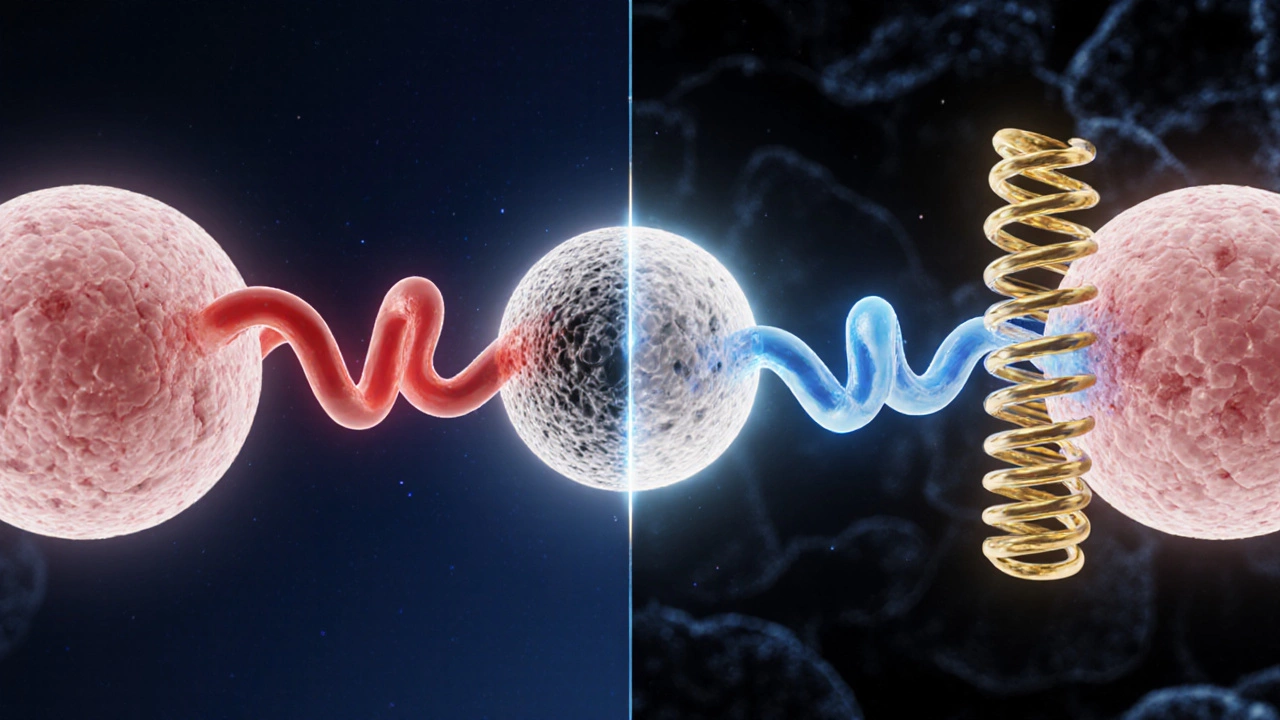
- Oct, 18 2025
- 0
Diabetes Treatment Calculator
Current Diabetes Metrics
Enter your current HbA1c percentage and weight to see potential outcomes with Cagrilintide.
Estimated Outcomes with Cagrilintide
How This Compares
Cagrilintide provides more significant HbA1c reduction and weight loss compared to other common treatments.
| Treatment | HbA1c Reduction | Weight Loss |
|---|---|---|
| Cagrilintide | 1.8-2.2% | 12-15 kg |
| Tirzepatide | 1.5-1.9% | 8-10 kg |
| Semaglutide | 1.3-1.6% | 5-7 kg |
| Metformin | 0.8-1.2% | 0-2 kg |
If you’ve been keeping an eye on the latest headlines in diabetes treatment, you’ve probably seen the buzz around a brand‑new medicine that promises better blood‑sugar control and weight loss. That drug is new diabetes drug 2025, officially named Cagrilintide - a dual GLP‑1/GIP receptor agonist that hit the market early this year. Below we break down what makes Cagrilintide different, who should consider it, and what to expect once you start the medication.
Why a New Drug Matters in 2025
Type 2 diabetes (T2D) affects more than 460 million adults worldwide, and the prevalence keeps rising. Traditional options like Metformin - the first‑line oral agent - work well for many but often fall short when patients need stronger glycaemic control or weight management. In the past decade, the explosion of GLP‑1 receptor agonists (e.g., semaglutide, dulaglutide) shifted the treatment landscape, offering cardiovascular benefits and notable weight loss. Yet doctors still wrestle with patients who don’t achieve target HbA1c levels or who experience gastrointestinal side effects.
Meet Cagrilintide: The Dual GLP‑1/GIP Agonist
Unlike earlier drugs that target only the glucagon‑like peptide‑1 (GLP‑1) pathway, Cagrilintide activates both the GLP‑1 and glucose‑dependent insulinotropic polypeptide (GIP) receptors. GIP is a gut hormone that, when combined with GLP‑1 activation, amplifies insulin secretion and promotes healthier fat distribution. The synergy translates into three key clinical advantages:
- Lower average HbA1c reductions of 1.8-2.2% in phase‑III trials.
- Average weight loss of 12-15 kg after 52 weeks, surpassing most GLP‑1‑only agents.
- Improved lipid profile and modest blood‑pressure drops, hinting at broader cardiometabolic benefits.
The drug is administered once weekly via a pre‑filled auto‑injector, similar to other weekly GLP‑1 products, making adherence easier for busy adults.
How Cagrilintide Stacks Up Against Existing Options
| Drug | Mechanism | HbA1c ↓ (average) | Weight loss (kg) | Typical side effects |
|---|---|---|---|---|
| Cagrilintide | Dual GLP‑1/GIP agonist | 1.8-2.2% | 12-15 | Nausea, mild GI upset |
| Tirzepatide (Mounjaro) | Dual GLP‑1/GIP agonist (earlier generation) | 1.5-1.9% | 8-10 | Nausea, vomiting, constipation |
| Semaglutide (Ozempic) | GLP‑1 agonist | 1.3-1.6% | 5-7 | GI disturbances, injection site reactions |
| Metformin | Biguanide, lowers hepatic glucose production | 0.8-1.2% | 0-2 (neutral) | Diarrhea, B12 deficiency (long‑term) |
| SGLT2 inhibitor (e.g., Empagliflozin) | Blocks renal glucose reabsorption | 0.5-0.8% | 2-4 | UTIs, genital infections, dehydration |
Notice how Cagrilintide nudges the HbA1c and weight‑loss numbers higher than its peers while keeping side‑effects in a familiar GI‑centric range.

Who Should Consider Cagrilintide?
Guidelines from the FDA and the EMA place Cagrilintide in the second‑line or add‑on category for adults with:
- HbA1c ≥ 8.5% despite metformin monotherapy.
- Significant overweight or obesity (BMI ≥ 30 kg/m²) where weight loss is a therapeutic goal.
- Established cardiovascular disease, given the emerging cardio‑protective data from the CAGRI‑CVOT trial (2024).
Patients with a history of severe pancreatitis, gastroparesis, or who are on dialysis should discuss alternatives, as the safety profile in these groups is still being clarified.
Starting the Medication: Dosage and Titration
Initiation follows a “start low, go slow” approach to mitigate nausea:
- Week 1: 0.25 mg subcutaneously once weekly.
- Week 2-4: Increase to 0.5 mg if tolerated.
- Week 5 onward: Target maintenance dose of 1.5 mg, with the option to go up to 2.0 mg for maximal effect.
Patients should inject on the same day each week, rotating sites (abdomen, thigh, upper arm) to reduce local reactions.
Potential Side Effects and How to Manage Them
Most users report mild to moderate gastrointestinal issues during the first month. Here’s a quick cheat‑sheet:
- Nausea: Eat smaller, more frequent meals; avoid high‑fat foods.
- Vomiting: If persistent after dose escalation, pause for 1 week and restart at the previous tolerated dose.
- Diarrhea: Hydrate well; consider an over‑the‑counter loperamide if needed.
- Injection site redness: Rotate injection sites; use a fresh needle each time.
Rarely, patients experience pancreatitis or gallstone formation; any severe abdominal pain warrants immediate medical attention.

Cost, Insurance Coverage, and Access
In Australia, the Pharmaceutical Benefits Scheme (PBS) has listed Cagrilintide under a special authority scheme for patients meeting the clinical criteria above. The out‑of‑pocket cost after subsidy is roughly AUD 120 per month. Private insurers in the US and UK are beginning to add it to their formularies, often with a prior‑authorization requirement.
If you don’t qualify for subsidy, many manufacturers offer patient‑support programs that provide the first three months at a reduced price.
Key Takeaways
- Cagrilintide is the first approved dual GLP‑1/GIP agonist, offering superior HbA1c reduction and weight loss.
- It’s best for adults with sub‑optimal control on metformin and a need for weight reduction.
- Side effects are mainly GI‑related and can be managed with gradual dose titration.
- Insurance coverage is expanding, and subsidy programs help offset the cost.
Frequently Asked Questions
How does Cagrilintide differ from Tirzepatide?
Both drugs activate GLP‑1 and GIP receptors, but Cagrilintide has a longer half‑life and a stronger GIP component, which translates into slightly greater weight loss and HbA1c improvement.
Can I use Cagrilintide if I’m already on an SGLT2 inhibitor?
Yes, many clinicians combine them to attack glucose from both renal and hormonal pathways, but monitor kidney function and watch for dehydration.
What happens if I miss a weekly injection?
Take the missed dose as soon as you remember, as long as it’s within 3 days. If more than 3 days have passed, skip it and resume your regular schedule to avoid overdose.
Is Cagrilintide safe during pregnancy?
Current data are limited; the drug is classified as pregnancy category C. Women who are pregnant or planning pregnancy should discuss alternatives with their endocrinologist.
How long will I need to stay on Cagrilintide?
Most patients stay on the medication indefinitely, as it helps maintain glycemic control and weight loss. Your doctor will reassess every 6‑12 months.
Nikhil Verma
I'm a dedicated physician with a passion for exploring the intricacies of medicine, focusing on the unique healthcare challenges in India. I spend much of my spare time writing articles aimed at improving public understanding of health issues. Balancing my clinical practice and writing allows me to reach a wider audience, sharing insights and fostering a deeper appreciation for medical advancements. I derive immense satisfaction from both treating patients and engaging with readers through my writing.